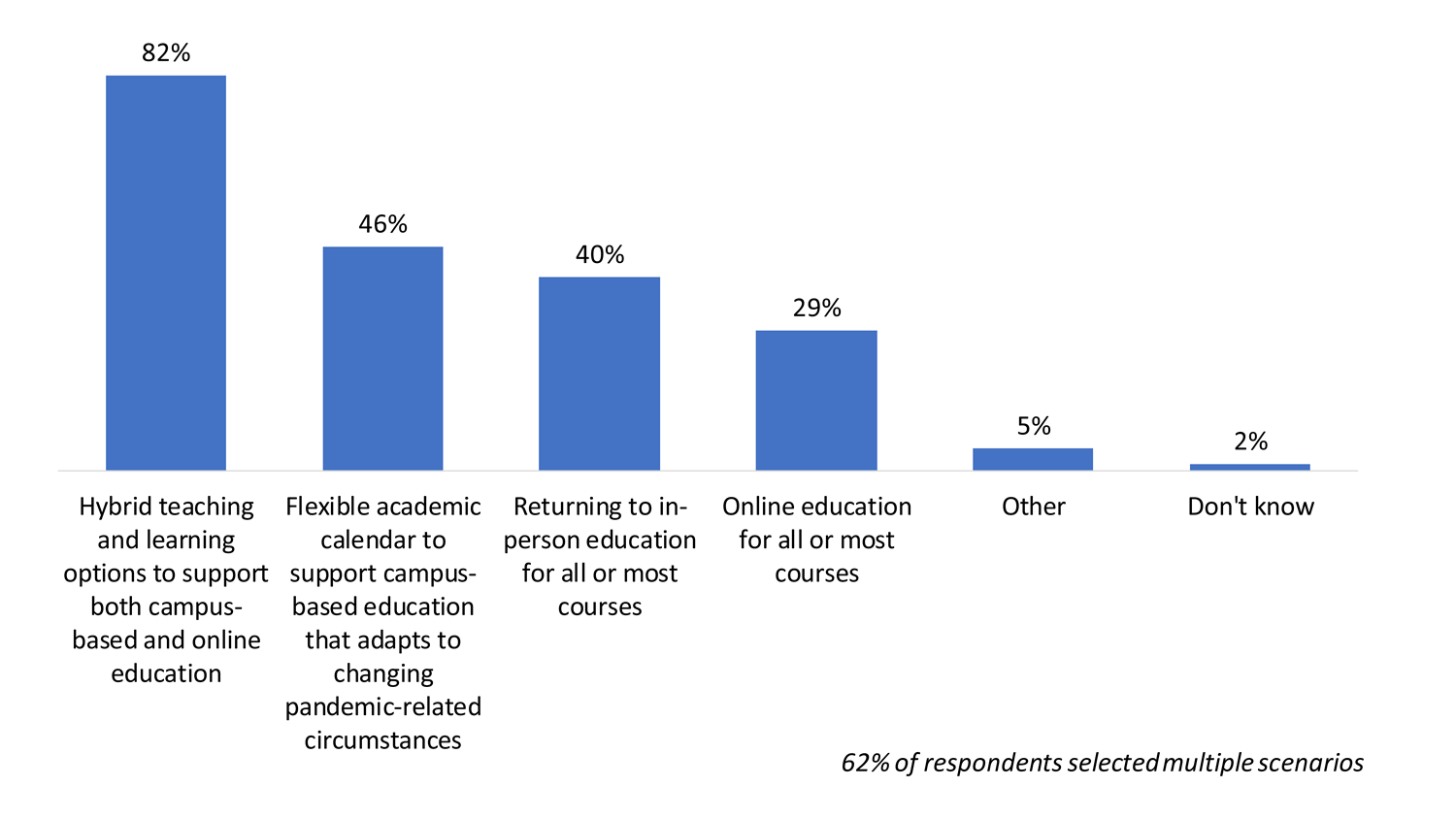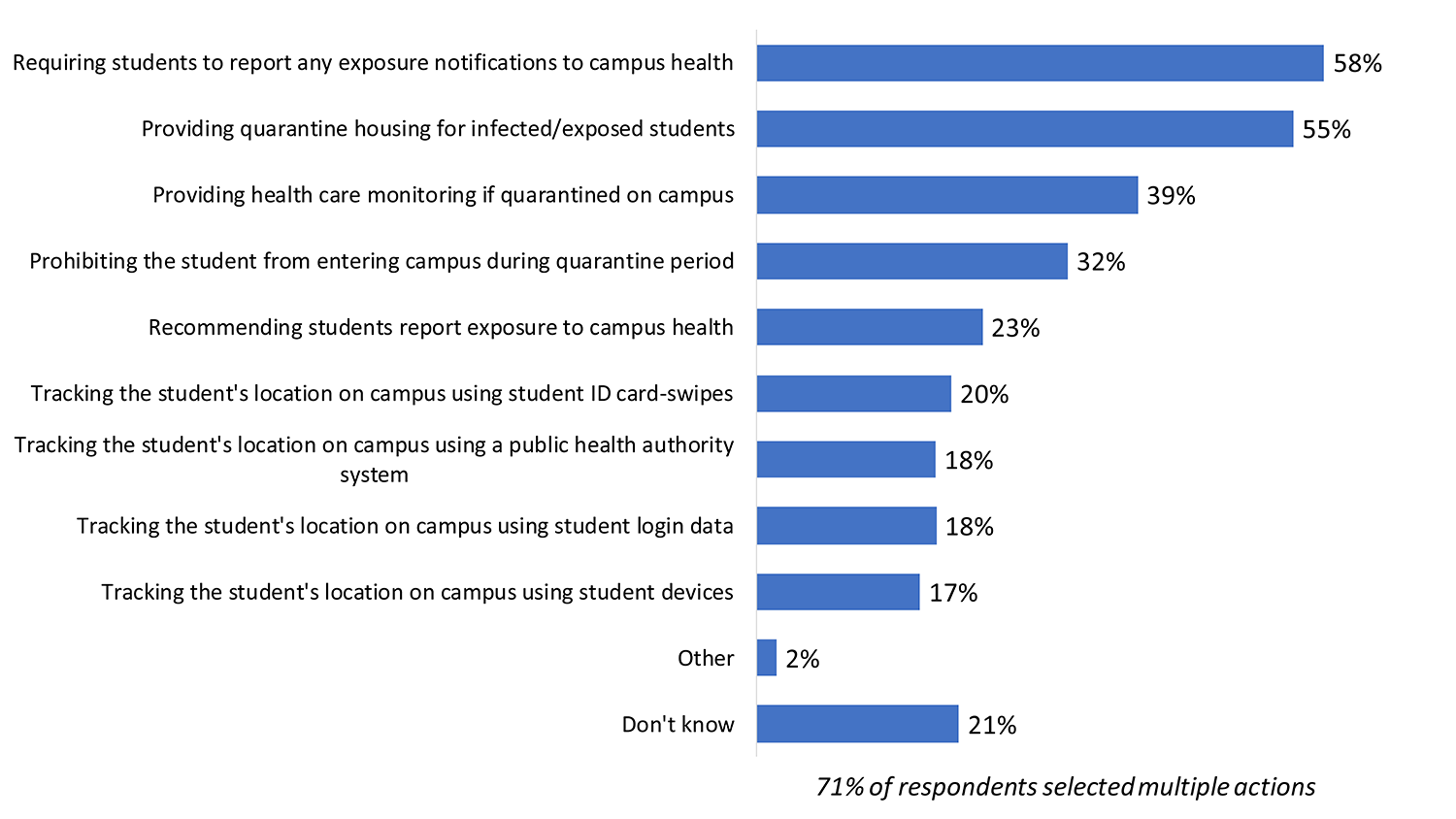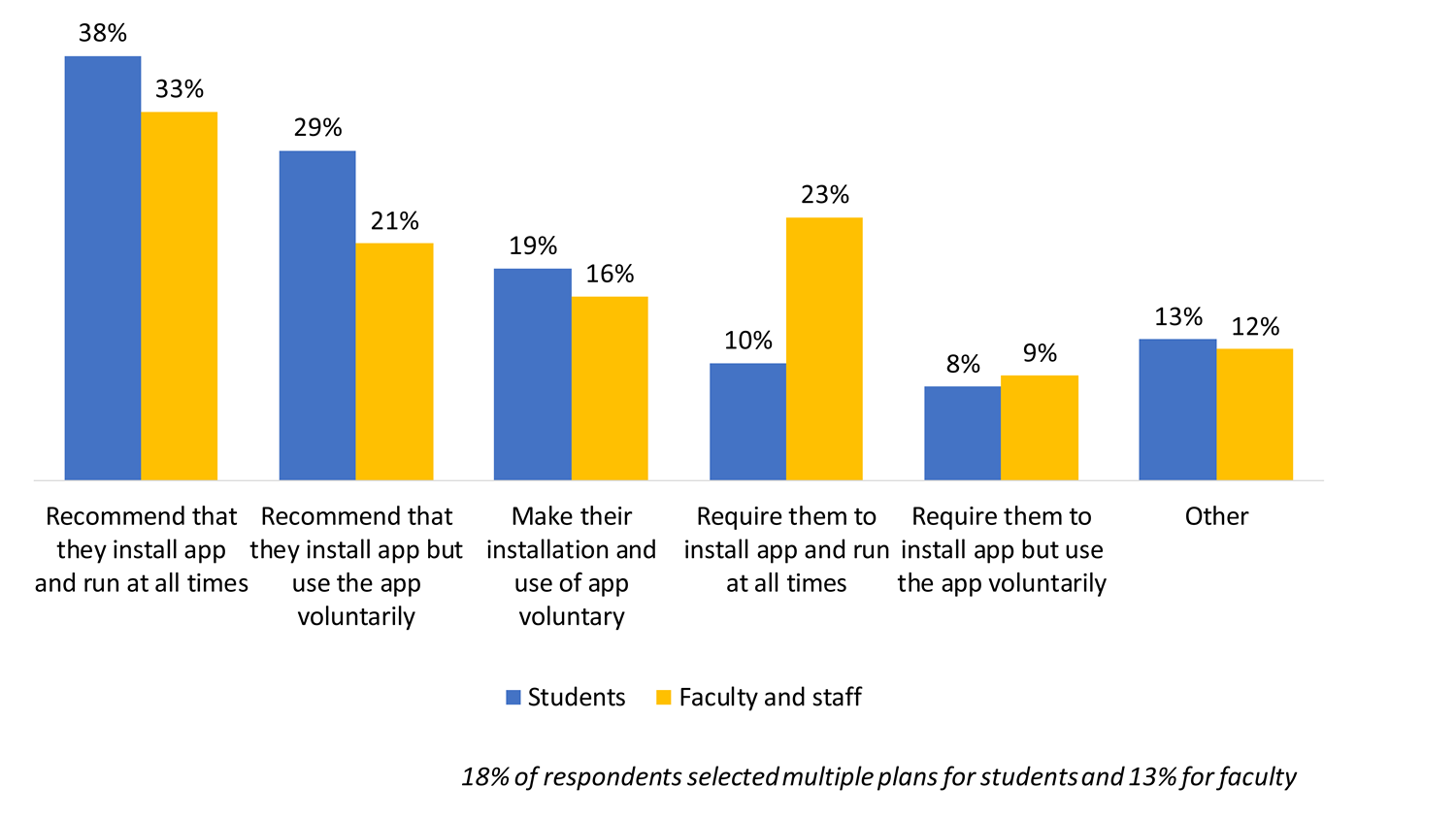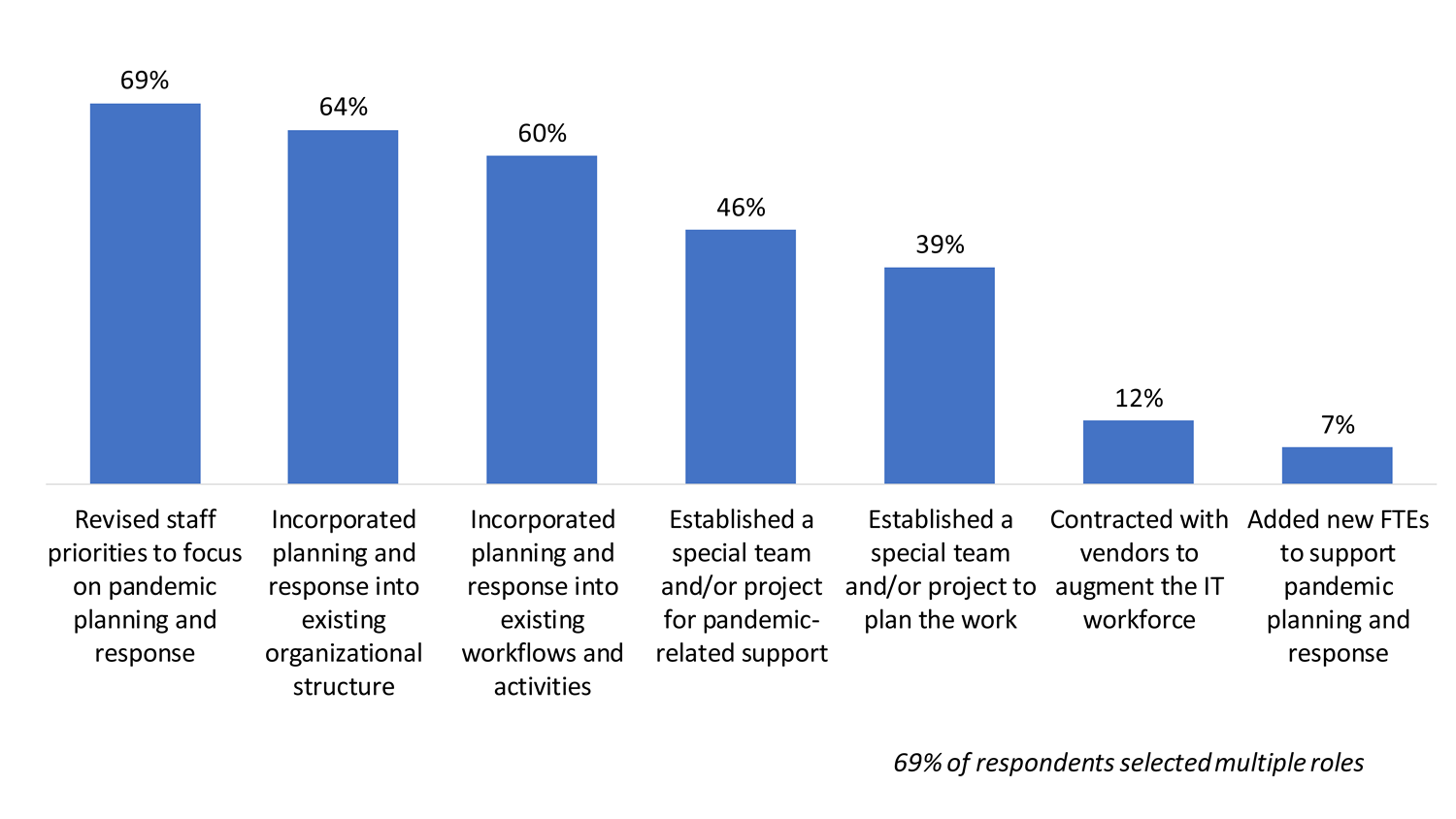As colleges and universities contemplate various scenarios for the fall academic terms, campus leaders are deliberating what their institution should do to protect the health and safety of campus constituents and are exploring the role that technology can play in those efforts.

As the COVID-19 pandemic upends higher education in 2020, institutions are relying on digital alternatives to missions, activities, and operations. Challenges abound. EDUCAUSE is helping institutional leaders, IT professionals, and other staff address their pressing challenges by sharing existing data and gathering new data from the higher education community. This report is based on an EDUCAUSE QuickPoll. QuickPolls enable us to rapidly gather, analyze, and share input from our community about specific emerging topics.1
The Challenge
Colleges and universities are struggling to prepare for a fall unlike any other. This spring, institutions managed the pandemic as a short-term crisis. The coming academic year demands a different approach, one of long-term adaptation to an ongoing and evolving risk. Health presents the greatest risk and perhaps the greatest uncertainty as well. In the face of strong commitments to restore campus-based education and operations, how can institutions safeguard their constituents' health? How are institutions preparing to use technology to support pandemic health management?2
The Bottom Line
Fall is just a few weeks away, but many IT leaders lack clarity about their institutions' health management plans. Many institutional leaders are still waiting for guidelines from state and local health authorities. With so much uncertainty, institutions are settling on highly flexible scenarios that can adapt the institution, the academic calendar, and individual courses to changing guidelines, outbreaks, and circumstances. Technology can contribute to pandemic health management, particularly in the areas of workplace safety management, health screening, and surveys gauging the readiness of students, faculty, and staff to return to campus. More intrusive uses of technology, such as contact tracing, physical distance monitoring, and location and exposure tracking, depend on both a quickly changing solution space and policies that might clash with the institution's culture. These great uncertainties and complexities impede IT organizations from effectively choosing and deploying solutions and support, but time is running short.
The Data: Institutional Context
Institutions are planning around the most flexible scenarios possible for the fall. Respondents at most institutions (82%) are planning for hybrid teaching and learning to support both campus-based and online education (see figure 1). About six in ten (62%) institutions are using multiple scenarios. The most common combination guiding planning at 43% of institutions, is a hybrid teaching and learning environment and a flexible academic calendar that can adapt to changing circumstances.

Most institutions will impose some form of quarantine if students test positive for COVID-19. More than seven in ten institutions plan to ask or require students to report if they test positive for COVID-19 (71%), and three-quarters (74%) will impose a quarantine if students report they have tested positive. Fewer institutions, though, are requiring or recommending that students report they have tested positive and also are planning to impose quarantines (61%). More institutions are requiring students to disclose a positive COVID-19 test than are simply recommending such disclosures (see figure 2). Location tracking is less widespread: fewer than half of respondents' institutions (39%) are planning some form of location tracking for students who test positive for COVID-19.

The Data: Health-Related Uses of Technology
Most uses of technology to support fall health management are focused on health screening, workplace safety management, and surveys of readiness to return to campus. The least common planned or considered uses were for location tracking (48% of respondents' institutions had no plans to do this) and physical distance monitoring (39% had no plans) (see figure 3). Roughly a quarter of respondents were uncertain about their institutions' plans to use technology to help manage the pandemic this fall. About two in ten institutions (22%) plan to use a state and/or local health authority system for contact tracing.

Specific technologies are still being chosen. Except for health screening, few respondents were able to provide information about the specific technical solutions their institution is planning to use to manage health during the pandemic (see tables 1 and 2). As is often the case with novel technology needs, custom applications and the repurposing of existing applications are as common as new products.
Table 1. Sources of technology solutions for pandemic planning and response
|
What product(s) or services are you using? |
Health Screening |
Workplace Safety Management |
Exposure Tracking |
Contact Tracing |
Physical Distance Monitoring |
|---|---|---|---|---|---|
|
New feature/app of product(s) we already use |
19% |
23% |
27% |
32% |
28% |
|
New product(s) acquired for this purpose |
19% |
15% |
27% |
32% |
17% |
|
Homegrown for this purpose |
48% |
50% |
41% |
21% |
28% |
|
Other |
13% |
12% |
5% |
16% |
28% |
|
N |
62 |
26 |
22 |
19 |
18 |
Table 2. Products for pandemic planning and response
|
New Feature of Existing Product |
New Product |
Other |
|---|---|---|
| Health Screening | ||
|
• App Armor • Campus Clear • Google Forms • HealthCheck 360 • Qualtrics • Qualtrics/Rave • Rave • TeamDynamix: ITSM & Project Portfolio Management Software |
• Appian Campus Pass • CampusClear • GHD • healthfully.io • IBM • Infrared temp scanners, Covid testing equipment • Looking at multiple different options and piloting them now: Envoy, Qualtrics, Healthy Together, Campus clear • ServiceNow • Survey Monkey • Temperature monitoring |
• Self-report via a paper form • Google Forms • A very persistent school nurse • PDF with checkboxes • Qualtrics survey tool • Regional health care system • We are using our College of Pharmacy and Health Sciences to conduct COVID-19 testing with test kits provided by a private manufacturer. |
| Workplace Safety Management | ||
|
• Blackboard/Panopto • Canvas teaching module • LMS and DocuSign for workflow • Qualtrics • Qualtrics/Rave |
• Appointments Plus, HelloSign |
|
| Exposure Tracking | ||
|
• Aerohive APs and possibly Aruba switches • Cisco/Splunk Wi-Fi • Qualtrics • Qualtrics/Rave • Rave • Splunk |
• healthfully.io • SurveyMonkey |
• Self-report via a paper form |
| Contact Tracing | ||
|
• Aruba Access Points • Aruba Central (wireless network tool) • Campus Clear • Qualtrics |
• Covidwatch • healthfully.io • IBM |
• Class schedules • Reviewing Qualtrics and Ready Education • Staff fill out Excel sheet |
| Physical Distance Monitoring | ||
|
• Wi-Fi reports to safety • Zoom • Zoom, YuJa, Adobe |
• CAE Zoom update • ClearPass |
• Current surveillance cameras • Manually done by community effort • We are adjusting classroom use and will have faculty police social distancing. |
Fewer than 40% of responding institutions have settled on plans for using mobile apps to support pandemic management. Of those, most institutions are recommending that students, faculty, and staff use such mobile apps (see figure 4), either by running them at all times or by using them voluntarily. Few are imposing any requirements related to mobile app usage. Those who are more than twice as likely to require faculty and staff to using mobile apps to support pandemic management than students.

The Data: IT's Role in Planning
The CIO has a seat at the table. About three-quarters of respondents (73%) reported that their institution's CIO is a member of the pandemic planning leadership team (see figure 5). At many institutions, IT's involvement in pandemic leadership ends there. Only half of institutions are including the IT organization in institutional pandemic planning and oversight.

The IT organization is absorbing pandemic planning into its existing workload, structure, and activities. Although quite a few institutions have established a special team and/or project for pandemic support (46%) or planning (39%), most are incorporating pandemic planning and support into their existing organizational structures (64%) and workflows (60%) (see figure 6). Very few institutions have provided the IT organization with more resources; most have had to find resources by revising existing staff's priorities.

Common Challenges
Lack of clarity about the fall persists. When we asked respondents to describe the biggest unresolved IT challenges in supporting health-related pandemic planning and response for this fall, more than half wrote about uncertainty and under-communication within their institution or lack of guidance from state and local health authorities. These same challenges have dogged institutions for weeks, and IT leaders are getting increasingly nervous about having time to prepare. Not every challenge pertained to health management. Comments included the following:
- "We do not have a plan for contact tracing, health reporting, or monitoring determined yet. It is impossible to plan for every scenario."
- "Moving target for requirements. Simply throwing 'technology' at a problem doesn't make it go away; we need to understand the desired outcomes in order to recommend a solution. However, since guidelines are not fixed, we're being asked to design solutions for outcomes that may change. It often feels like we're putting the cart before the horse."
- "Schools and colleges are still determining their plans for fall in terms of schedules and delivery methods, so IT can't begin to move forward on plans until we know directions. Also our local state health department has not released guidance on contact tracing and symptom tracking, so we are unsure of the requirements and support we will get from the state."
- "The unknown nature of what will happen in the fall—we think we are planning for the most likely scenarios, but you never know."
- "For my institution, simply getting clarity from campus leadership regarding expectations for in-class vs. online teaching modality. Campus is publicly stating a 'normal' fall, but it's obvious the faculty have been asked to be prepared for a lot of online. Faculty are still in limbo with respect to expectations for in-class vs. online activities."
Technology might be the easy part, but that doesn't mean it isn't hard. Technical challenges of various sorts were the next most common difficulty:
- "Scaling up our homegrown and quickly deployed screening application, supporting the increased dependence on collaborative technologies for teaching and working."
- "Hybrid teaching, hands down. This is the most challenging aspect of IT work for fall and most at risk for not succeeding, due to excessively high levels of expectations for technology."
- "Build versus buy for technologies to assist reopening."
The institution's "honeymoon" with the IT organization may be over. Our surveys earlier this spring indicated that institutional leaders, faculty, and staff were almost uniformly grateful for their IT support. This survey produced several comments describing perennial struggles between IT staff and their constituents:
- "Ensuring our campus community continues to engage IT as a partner vs. shadow IT and including IT too late in the conversation."
- "IT demand is more than available resources, and too many unknowns out there."
- "Getting faculty equipment they need, versus what they want."
Technology's role in health management is probably less critical than the role of clear guidelines and processes. A recent simulation of COVID-19 in a large, residential university found that the most promising practices are widespread and accurate testing, moving large classes online, minimizing social contacts with those outside the campus, and "preparing to accommodate unpredictable absences."3
Fall is coming. Unless institutions and health authorities can provide more clarity and decisiveness soon, the ability of IT leaders and staff to select and deploy reliable, cost-effective solutions to managing health is at risk. Even so, resources might be the larger challenge. Having chosen scenarios that allow for the most flexibility possible—which is quite sensible for a situation as fluid as this pandemic—institutions are committing their workforce to extensive planning and spending to "prepare for the unpredictable."
EDUCAUSE will continue to monitor higher education and technology related issues during the course of the COVID-19 pandemic. For additional resources, please visit the EDUCAUSE COVID-19 web page. All QuickPoll results can be found on the EDUCAUSE QuickPolls web page.
For more information and analysis about higher education IT research and data, please visit the EDUCAUSE Review Data Bytes blog as well as the EDUCAUSE Center for Analysis and Research.
Notes
- QuickPolls are less formal than EDUCAUSE survey research. They gather data in a single day instead of over several weeks, are distributed by EDUCAUSE staff to relevant EDUCAUSE Community Groups rather than via our enterprise survey infrastructure, and do not enable us to associate responses with specific institutions. ↩
- The poll was conducted on June 15–16, 2020. Respondents represented only 127 institutions, presumably due to the uncertainty about the fall. The poll consisted of 18 questions and took respondents a median time of 5 minutes and 21 seconds to complete. Poll invitations were sent to participants in EDUCAUSE community groups focused on IT leadership and instructional technology. Most respondents (119) represented US institutions. Respondents from Algeria, Canada, Portugal, and the United Kingdom also participated. An appropriately diverse and well-balanced range of institution sizes and Carnegie Classifications participated. ↩
- Philip T. Gressman and Jennifer R. Peck, "Simulating COVID-19 in a University Environment," unpublished paper, June 8, 2020. ↩
Susan Grajek is Vice President of Communities and Research at EDUCAUSE.
© 2020 Susan Grajek. The text of this work is licensed under a Creative Commons BY-NC-ND 4.0 International License.
